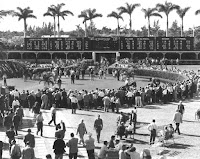 |
| Little Yankee Stadium, State Archives of Florida |
Little Yankee Stadium
2800 SW 8th Ave, Fort Lauderdale, FL 33315
954-828-7275
Some called him “candidate for a nuthouse.” But Floyd Vance
Hull, attorney and father, showed the city of Fort Lauderdale what could be
done with a little elbow grease and a lot of community spirit.
In June of 1963 he presented a plan for a Little League ballpark to the city commission and its parks and advisory board. The proposed site was a “swampy” piece of “surplus” city land, not far from where the Yankees trained.
The catch: the park wouldn’t cost taxpayers a dime;
it would be paid for with donations. He asked only that the city prioritize Little
League operations for 10 years in exchange for a dollar a year. Hull’s proposal
raised eyebrows and stoked ridicule. Mayor Cy Young held little regard for the
idea and had wanted to sell the land.
Perhaps on a dare or convinced by Hull’s enthusiasm, Fort
Lauderdale approved the plan in September 1963.
Hull delivered. By January 1965 he had raised more than $200,000 in cash, materials and labor. About 1,100 contributors stepped up to the plate (and were individually credited per terms of agreement); donations continued to flow as the first phase of the project was completed that month.
Over 60,000
cubic yards of fill was donated and then leveled at no charge. About 12,000
square feet of sod was laid by volunteers—mostly fathers, mothers, Little
League umpires and players. A slogan was adopted, “work now, play later.” Lighting eventually installed was deemed as
good as that of Yankee Stadium and the Orange Bowl.
Little Yankee Stadium transitioned from a crazy idea
to reality. City and county officials were “astonished.” Hull lauded retired U.S
Army Reserve Captain Alan Morton and his Fort Lauderdale engineering unit for bringing
the project to fruition. His team of 131 reservists worked with trucks on the
field as part of their weekend training commitment.
In mid-February 1965,
the Federal Little League and its senior division held tryouts for 24 teams
with slots for 400 kids, 9-15 years old. A tournament was held that summer. The
Broward County School Board installed 2,000 feet of fencing in exchange for rights
to play junior varsity football at the park, which soon held three baseball
fields and one football field. Sponsors such as Powell Ford lined up to help
pay for state tournaments.
By March 1971, stadium facilities, valued at $750,000 held
1,000 seats, included a press box, concession and restroom building. Little
League headquarters claimed the park to be the “finest facility of its kind in
the nation" and the “number one Little League facility in the world.”
The Big League World Series featuring 16-18 year olds, was
held at Fort Lauderdale’s Little League Stadium for 29 years until 1998. Slammed
by low attendance and difficulties securing hotel accommodations for its nine-day schedule, the series moved to another state. (The series ran its course from 1968 until
after the 2016 games.)
Today Fort Lauderdale’s Floyd Hull Stadium, a city park,
features baseball/softball facilities, grills, tables, swings and more for
recreation.
Floyd Hull, president of the local Federal Little League, the Little League Stadium and director of the Big League World Series retired in 1998 or 1999. He was born in Fort Lauderdale, graduated from Pompano Beach High School and the University of Florida law school. He served in the U.S. Army Judge Advocate General’s Corps (JAG) from 1951-1954 and as municipal judge in Fort Lauderdale. A husband and father of four, he died at 87 in 2015.
His was a life
well lived and testament to “people power.”
Today we need more with Hull’s vision, enthusiasm and ability
to rally community spirit.
Sources:
Fort Lauderdale News, Jan. 10, 1965
Fort Lauderdale News, May 21, 1967
Fort Lauderdale News, March 30, 1971
Fort Lauderdale News, April 3, 1973
Sun-Sentinel, Sept. 10, 1998
Sun-Sentinel, Dec. 29, 2015
Tags: Little Yankee Stadium, Floyd Hull, Fort Lauderdale sports, Florida sports, baseball, Fort Lauderdale history, Little League, Big League World Series










